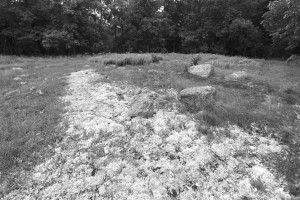It’s Only Natural—October 2015
Lichen Communities on Bald-Topped Mountains
By Hans M. Carlson
Until roughly 13,000 years ago, glaciers scoured and sculpted New England’s hills into the ridges, domes and cliffs we find so familiar today. The melting ice deposited soils in some places, but much of the post-glacial landscape was scraped, barren and rocky. Even in the thinnest glacial till, however, plants colonized and millennia of their living and dying created soils in most places.
In some high and exposed places, harsh weather and periodic fires prevented soil development, and these “balds” harbor unique ecologies, especially for southern New England. Regionally, Mount Everett and Race Mountain have bald tops, as does Canaan Mountain. Within Great Mountain Forest (GMF), Blackberry Hill and the point we call “The Matterhorn” are also rocky outcroppings that provide rare open environments in the forest.
Balds offer berries, sun and views for those who hike there, and also provide important landscape structure in an otherwise forested region. Their sunny, warm and dry environments can be wildlife rich – Canaan Mountain, for example, provides important habitat to locally rare timber rattlesnakes – though balds also provide challenging ecological conditions for plants, as they are characteristically dry and acidic.
On these bald tops, “crevice” communities form in bedrock cracks where soil accumulates and moisture can be retained. The amount of colonization in an opening depends on the depth and moisture retaining abilities of the soil, with lichens forming on nearly bare rock, then mosses, graminoids, herbs and finally shrubs, like low-bush blueberries, ultimately populating areas with increasing amounts of soil.
Plant life grows slowly in these places. You will find stunted oaks with twisted branches and pruned canopies that may be decades old. The thin soils around the edges of rocky areas do not retain moisture, so trees and shrubs emphasize root growth over stem and branch growth, which enables them to live in the harsh parameters.
Within these stunted trees, bedrock is typically covered by crustose, foliose or fruticose groups of lichens, and these are the most ecologically interesting aspects of the balds in our area. Crustose lichens are the flat growths that are nearly impossible to remove from the rock, while foliose lichens look more leaf-like, though still rather two-dimensional. Fruticose lichens, like Cladonia or reindeer moss, are more three-dimensional and hold more moisture than the others. Cladonia is prevalent on the barren grounds of the Canadian north, proving how unique these places are for southern New England.
The lichens’ presence points to another rare quality of these rocky areas, and is the reason they should be entered with caution–crustose lichens are rugged, but the others are easily crushed underfoot, especially in dry weather when they are a stiff, crypto-biotic state. These sites also contain fragile pin-cushion lichen communities which are equally delicate. Every effort should be made to remain on the trail or, if no trail exists, to stand on open bedrock or other vegetation.
These communities of lichens represent centuries of growth, though we don’t tend to think of things like mosses and lichens as being old-growth. In fact, they are ecologically just as precious as the oldest hemlock, maybe even more so because they can be destroyed or damaged so easily. It takes a bit of effort to scale the human imagination down to see the ancient qualities of these humble plants eking out a living on balds and barrens, but it’s worth doing as you enjoy the view, and a handful of blueberries.
Photo by Michael Gaige.

